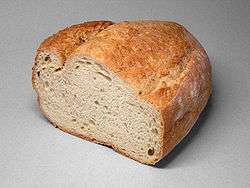Soda bread
Soda bread is a variety of quick bread traditionally made in a variety of cuisines in which sodium bicarbonate (otherwise known as "baking soda", or in Ireland, "bread soda") is used as a leavening agent instead of the traditional yeast. The ingredients of traditional soda bread are flour, baking soda, salt, and buttermilk. The buttermilk in the dough contains lactic acid, which reacts with the baking soda to form tiny bubbles of carbon dioxide. Other ingredients can be added, such as butter, egg, raisins, or nuts. An advantage of quick breads is their ability to be prepared quickly and reliably, without requiring the time-consuming skilled labor and temperature control needed for traditional yeast breads.
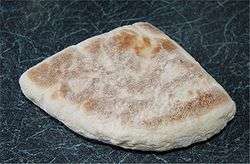 An Irish soda farl; made by cutting a flattened round of dough into four pieces, then baking. | |
| Alternative names | flat, triangular bread with pale surface irregularly covered with browning. |
|---|---|
| Type | Quick bread |
| Place of origin | North America[1] |
| Created by | Native Americans[1] |
| Main ingredients | Flour, sodium bicarbonate, salt, buttermilk |
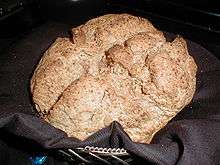
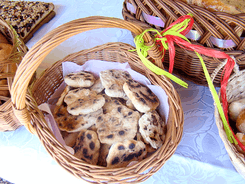
Preparation
Soda bread is made with coarse flour either white or whole meal, or a mix of the two depending on the recipe. High protein flour is not needed for this bread as the texture is described as being "moist and crumbly". Other whole grains like rolled oats may be added to create different varieties.[2] This bread does not have to be kneaded and bakers caution that kneading can toughen the dough.[2][3]
Buttermilk or sour milk is traditionally the liquid ingredient due to its reaction with the soda.[2]
Some recipes may add olive oil or eggs, or sweeteners like molasses, sugar, treacle, or honey, but these are not part of the basic recipe.[2]
Origin
During the early years of European settlement of the Americas, settlers used soda or pearl ash, more commonly known as potash (pot ash) or potassium carbonate, as a leavening agent (the forerunner to baking soda) in quick breads.[4] In the US, soda breads were first publicised by Amelia Simmons as a quick and cheap method of bread making in her book American Cookery,[5] published in 1796. By 1824, The Virginia Housewife by Mary Randolph was published containing a recipe for Soda Cake.[6]
After baking soda was developed in the US in 1846 breads, griddle cakes and scones with bicarbonate of soda, plus cream of tartar or tartaric acid became popular in European countries.[7]
Ireland
Traditional Irish bread was historically cooked on a griddle as flatbread because the domestic flours did not have the properties needed to rise effectively when combined with yeast. Baking soda offered an alternative, but its popularity declined for a time when imported high-gluten flours became available. Brown soda bread (served with smoked salmon) reappeared on luxury hotel menus in the 1960s. Modern varieties can be found at Irish cafes and bakeries, some made with Guinness, treacle, walnuts, and herbs, but the sweetened version with caraway and raisins is rarely seen anymore. Soda bread made with raisins is colloquially called "Spotted Dog" or "Spotted Dick".[3]
In Ireland, the flour is typically made from soft wheat, so soda bread is best made with a cake or pastry flour (made from soft wheat), which has lower levels of gluten than a bread flour. In some recipes, the buttermilk is replaced by live yogurt or even stout. Because the leavening action starts immediately (compared to the time taken for yeast bread to rise), bakers recommend the minimum amount of mixing of the ingredients before baking; the dough should not be kneaded.
Various forms of soda bread are popular throughout Ireland. Soda breads are made using wholemeal, white flour, or both. In Ulster, the wholemeal variety is usually known as wheaten bread and is normally sweetened, while the term "soda bread" is restricted to the white savoury form. In the southern provinces of Ireland, the wholemeal variety is usually known as brown bread and is almost identical to the Ulster wheaten. In some parts of Fermanagh, the white flour form of the bread is described as fadge.[8][9]
The "griddle cakes", "griddle bread" (or soda farls in Ulster) take a more rounded shape and have a cross cut in the top to allow the bread to expand. The griddle cake or farl is a more flattened type of bread. It is cooked on a griddle, allowing it to take a more flat shape, and it is split into four sections. The soda farl is one of the distinguishing elements of the Ulster fry, where it is served alongside potato bread, also in farl form.[10]
Scotland
In Scotland, varieties of soda breads and griddle sodas include bannocks and farls (Scots: fardel, "a fourth"), "soda scones", or "soda farls", using baking powder or baking soda as a leavening agent giving the food a light and airy texture.[11][12][13]
Bannocks are flat cakes of barley or oatmeal dough formed into a round or oval shape, then cooked on a griddle (Scots: girdle). The most authentic versions are unleavened, but from the early 19th century bannocks have been made using baking powder, or a combination of baking soda and buttermilk or clabbered milk.[11] Before the 19th century, bannocks were cooked on a bannock stone (Scots: stane), a large, flat, rounded piece of sandstone, placed directly onto a fire, then used as a cooking surface.[14] Several varieties of bannock include Selkirk bannocks, beremeal bannocks, Michaelmas bannock, Yetholm bannock, and Yule bannock.[11]
The traditional soda farl is used in the full Scottish breakfast along with the potato scone (Scots: tattie scone).
Serbia
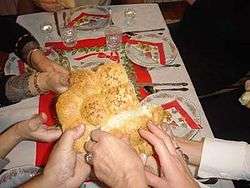
In Serbian tradition, soda bread is prepared by various rules and rituals. A coin is often put into the dough during the kneading; other small objects may also be inserted. At the beginning of Christmas dinner, the česnica is rotated three times counter-clockwise, before being broken among the family members. The person who finds the coin in his piece of the bread will supposedly be exceptionally lucky in the coming year. Before baking, the upper surface of the loaf may be inscribed with various symbols,[15] such as a Christogram, or stars, circles, and impressions of keys or combs.[16]
Australia
Damper is a traditional Australian bread prepared in a similar style to the pan breads found in North American and native Inuit cuisine. First documented in 1827 and prepared by farm-men, damper was a quick and easy way to prepare bread in the Australian bush.[17] The word "damper" derives from the English word "to snack" or to dampen the flour in the fire of one's appetite.[18]
References
- Society for the Preservation of the Soda Bread. Society for the Preservation of the Irish Soda Bread.
- "How to bake the perfect soda bread". The Guardian. 5 February 2014.
- "Secrets of the soda bread masters". BBC. 20 September 2016.
- "Archived copy". Archived from the original on 15 March 2012. Retrieved 2010-11-20.CS1 maint: archived copy as title (link)
- Simmons, Amelia; Mary Tolford Wilson (1984) [1958]. The First American Cookbook (1984 reprint ed.). Mineola, NY: Dover. ISBN 0-486-24710-4.
- The Virginia Housewife by Mary Randolph 1824
- English Bread and Yeast Cookery, Elizabeth David [Penguin:Middlesex England] 1977 (p. 517-8)
- "Fermanagh Gold Thread".
- "Irish Blessings Tours". Archived from the original on 14 July 2014.
- "Programmes - Most Popular - All 4".
- "Bannock". Practically Edible: The Web's Biggest Food Encyclopaedia. Archived from the original on 20 November 2008. Retrieved 2008-10-18.
- Ingram, Christine; Jennie Shapter (2003). BREAD: the breads of the world and how to bake them at home. (Originally published as The World Encyclopedia of Bread and Bread Making.) London: Hermes House. p. 54. ISBN 0-681-87922-X.
- Clayton, Bernard Jr. (2003). Bernard Clayton's New Complete Book of Breads. New York: Simon & Schuster. p. 555. ISBN 0-7432-3472-3.
- Feilden, Rosemary (1999). "Bannock Stane at Aberdeen University's Virtual Museum". Aberdeen University. Retrieved 12 November 2009.
- Plotnikova, A. A. (2001). "Чесница". In Svetlana Mikhaylovna Tolstaya and Ljubinko Radenković (ed.). Словенска митологија: енциклопедијски речник [Slavic mythology: encyclopedic dictionary] (in Serbian). Belgrade: Zepter Book World. pp. 577–78. ISBN 86-7494-025-0.
- Vukmanović, Jovan (1962). "Božićni običaji u Boki Kotorskoj" [Christmas traditions in the Bay of Kotor]. Zbornik za narodni život i običaje Južnih Slovena (in Serbian). Zagreb: The Yugoslav Academy of Sciences and Arts. 40: 491–503. Retrieved 4 January 2010.
- Austral English: A Dictionary of Australasian Words, Phrases and Usages By Edward Ellis Morris Cambridge University Press, 2011 p114
- One continuous picnic: a gastronomic history of Australia By Michael Symons Melbourne Univ. Publishing, 2007. p31
External links
| Wikimedia Commons has media related to Soda breads. |
| Wikibooks Cookbook has a recipe/module on |
